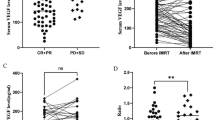Abstract
Purpose
We investigated the role of vascular endothelial growth factor C (VEGF-C) in esophageal squamous cell carcinoma (ESCC) by knocking down VEGF-C expression in the ESCC cell line EC9706.
Methods
Immunohistochemistry and in situ hybridization techniques were used to detect the expression of VEGF-C expression in ESCC tissues. We also investigated the relationship between VEGF-C expression and lymph node metastasis. We designed a siRNA expression plasmid for VEGF-C and transfected it into EC9706 cells. Stable clones were selected, and VEGF-C expression was analyzed by RT-PCR and western blotting. Cells were inoculated into nude mice. The expression of VEGF-C in the resulting tumors was analyzed by immunohistochemistry and in situ hybridization.
Results
VEGF-C is highly expressed in ESCC and correlated with lymph node metastasis, as high levels were observed in patients presenting with lymph node metastases relative to those who did not (P < 0.01). Transfection with VEGF-C-siRNA decreased the expression of VEGF-C mRNA and protein. ESCC cells stably transfected with VEGF-C-siRNA expressed very low levels of VEGF-C (P < 0.01 compared with control). This knockdown effect persisted when the cells were inoculated into nude mice and allowed to form tumors.
Conclusions
The siRNA-targeted knockdown of VEGF-C led to a significant reduction in VEGF-C expression. This siRNA technique could be used for gene therapy in ESCC.





Similar content being viewed by others
References
Ashihara E, Kawata E et al (2010) Future prospect of RNA interference for cancer therapies. Curr Drug Targets 11:345–360
Brummelkamp TR, Bernards R et al (2002) A system for stable expression of short interfering RNAs in mammalian cells. Science 296:550–553
Elbashir SM, Harborth J et al (2001) Duplexes of 21-nucleotide RNAs mediate RNA interference in cultured mammalian cells. Nature 411:494–498
Elbashir SM, Harborth J et al (2002) Analysis of gene function in somatic mammalian cells using small interfering RNAs. Methods 26:199–213
Gotoh H, Kanomata N et al (2009) Morphometric analysis of regional lymph nodes in surgically resected non-small cell lung cancer. Med Mol Morphol 42:162–166
Haussecker D, Huang Y et al (2010) Human tRNA-derived small RNAs in the global regulation of RNA silencing. RNA 16:673–695
Joukov V, Pajusola K et al (1996) A novel vascular endothelial growth factor, VEGF-C, is a ligand for the Flt4 (VEGFR-3) and KDR (VEGFR-2) receptor tyrosine kinases. EMBO J 15:290–298
Kodama M, Kitadai Y et al (2008) Vascular endothelial growth factor C stimulates progression of human gastric cancer via both autocrine and paracrine mechanisms. Clin Cancer Res 14:7205–7214
McCarter MD, Clarke JH et al (2004) Lymphangiogenesis is pivotal to the trials of a successful cancer metastasis. Surgery 135:121–124
Nathanson SD (2003) Insights into the mechanisms of lymph node metastasis. Cancer 98:413–423
Paavonen K, Horelli-Kuitunen N et al (1996) Novel human vascular endothelial growth factor genes VEGF-B and VEGF-C localize to chromosomes 11q13 and 4q34, respectively. Circulation 93:1079–1082
Paramo JC, Summerall J et al (2002) Validation of sentinel node mapping in patients with colon cancer. Ann Surg Oncol 9:550–554
Pisani P, Parkin DM et al (1999) Estimates of the worldwide mortality from 25 cancers in 1990. Int J Cancer 83:18–29
Song-liang Q, Guan-rui Y (1988) Precursor lesions of esophageal cancer in high-risk populations in Henan Province, China. Cancer 62:551–557
Stacker SA, Achen MG (2008) From anti-angiogenesis to anti-lymphangiogenesis: emerging trends in cancer therapy. Lymphatic Res Biol 6:165–172
Subramanya S, Kim SS et al (2010) RNA interference-based therapeutics for human immunodeficiency virus HIV-1 treatment: synthetic siRNA or vector-based shRNA? Expert Opinion Biol Therapy 10:201–213
Tammela T, Petrova TV et al (2005) Molecular lymphangiogenesis: new players. Trends Cell Biol 15:434–441
Vrekoussis T, Chaniotis V et al (2009) Image analysis of breast cancer immunohistochemistry-stained sections using image: an RGB-based model. J Anticancer Res 29:4995–4998
Wilson R, Purcell D et al (2009) Does RNA interference provide new hope for control of chronic hepatitis B infection. Antivir Ther 14:879–889
Xing-e L, Xiao-dong S et al (2004) Expression and significance of VEGF-C and FLT-4 in gastric cancer. World J Gastroenterol 10:352–355
Acknowledgments
This study was supported by Henan Innovation Project for University Prominent Research Talents (No. 2006KYCX016) and Tackle Key Problems in Science and Technology Key Project of Henan Province (No. 112102310088). We are very grateful to Director Sanshen Zhang of Anyang Tumor Hospital in Henan Province for collecting esophageal samples.
Conflict of interest
The authors declare that they have no conflict of interest.
Author information
Authors and Affiliations
Corresponding authors
Additional information
H. Zhang and Y. Yin contributed equally to this work.
Rights and permissions
About this article
Cite this article
Zhang, H., Yin, Y., Zhang, L. et al. The effects of vascular endothelial growth factor C knockdown in esophageal squamous cell carcinoma. J Cancer Res Clin Oncol 138, 133–139 (2012). https://doi.org/10.1007/s00432-011-1079-9
Received:
Accepted:
Published:
Issue Date:
DOI: https://doi.org/10.1007/s00432-011-1079-9




